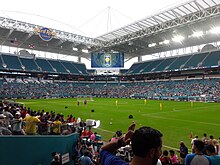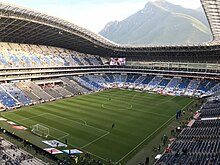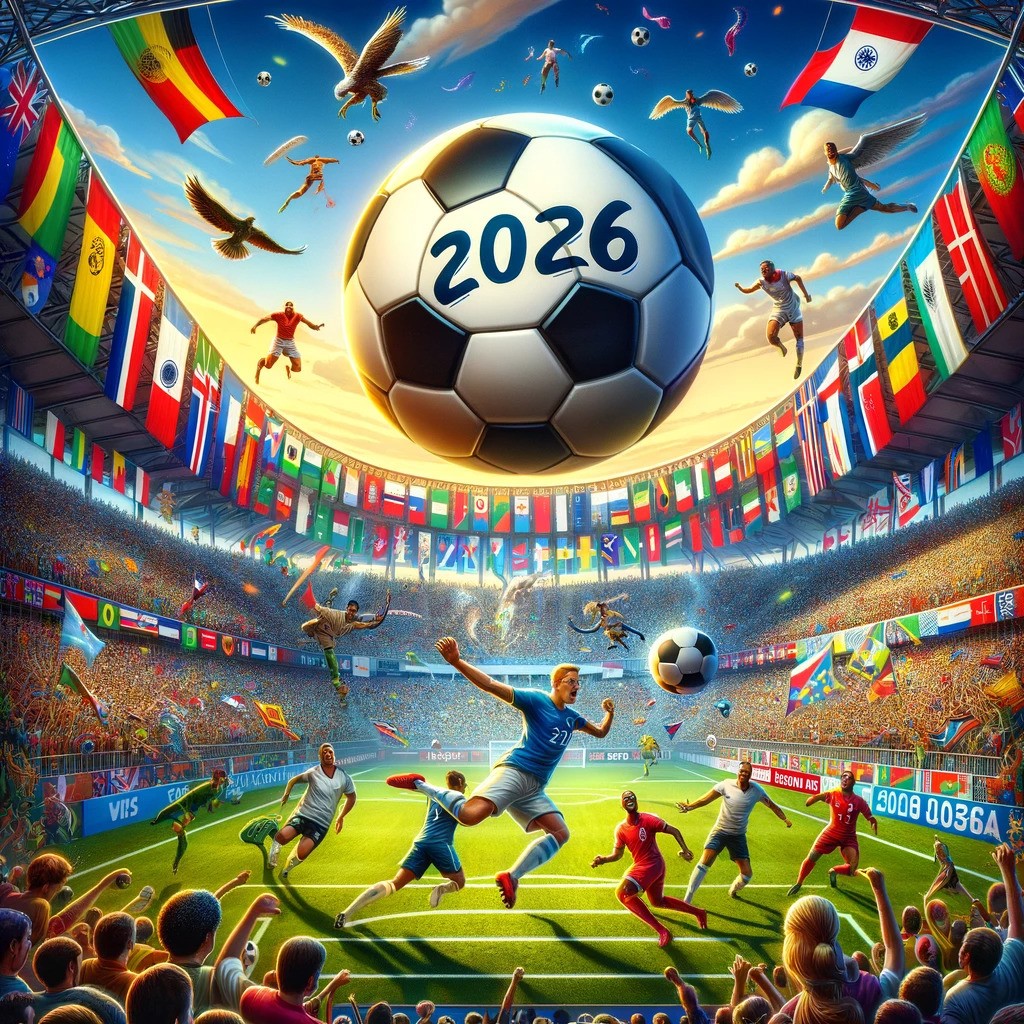A Comprehensive Guide to the 2026 FIFA World Cup: Host Cities, Stadiums, and Innovations
Are you ready for the most expansive FIFA World Cup yet? Set to kick off in 2026, this global football fiesta is making history. With Canada, Mexico, and the USA co-hosting, it’s not just a tournament; it’s a celebration across an entire continent. Imagine the excitement, the cheers, and the spirit of unity as fans from all corners of the globe gather for the love of football. This World Cup isn’t just another edition; it’s a groundbreaking event set to redefine international sports.
Historic Expansion: The First 48-Team Tournament
Think bigger and bolder, because the 2026 World Cup is shattering norms. For the first time ever, we’re seeing an expansion to 48 teams! What does this mean? More nail-biting matches, unexpected heroes, and the chance for smaller footballing nations to shine on the world stage. This change is more than just numbers; it’s about opening doors, creating new rivalries, and expanding the beautiful game’s global footprint. Get ready for a tournament that promises more action, more drama, and more unforgettable moments.
Host Nations: Canada, Mexico, USA
Three nations, one passion! Canada, Mexico, and the USA are joining forces to host this colossal event. Each country brings its unique flavor to the tournament, from the bustling streets of Mexico City to the tech-driven vibe of Silicon Valley, and the multicultural mosaic of Toronto. It’s a fusion of cultures, cuisines, and celebrations, all united by football. The question is, how will these diverse backdrops influence the World Cup experience? One thing’s for sure; it’s going to be an eclectic, once-in-a-lifetime adventure for players and fans alike.
The Bidding Process and Selection
The Bidding Process and Selection” for the 2026 FIFA World Cup was a comprehensive and transparent journey. Countries interested in hosting the World Cup had to present detailed plans covering various aspects such as stadium infrastructure, transportation, accommodation, and environmental impact.
This process was not just about selecting venues but also about evaluating the capability of the host nations to provide a memorable and efficient tournament experience. The bid evaluation included assessments of technical aspects, commercial potential, and the overall vision for the event.
Ultimately, the joint bid of Canada, Mexico, and the USA was selected, marking a significant decision in FIFA’s history for a collaborative, multi-nation approach.
Significance of a Tri-Nation Host
Three countries, one event – sounds like a recipe for complexity, right? But here’s the twist: it’s a masterstroke in international cooperation. The USA, Canada, and Mexico joining hands symbolize more than just shared hosting duties; it’s about unity, breaking down borders (figuratively, of course) for the love of the game. Imagine the logistical ballet, the cultural blend, and the economic boost. This isn’t just a tournament; it’s a statement about the power of collaboration in today’s world.
Overview of Host Cities
Let’s take a virtual tour of the host cities, shall we? From the electric atmosphere of Mexico City to the urban sophistication of Toronto and the Hollywood glam of Los Angeles – each city is set to bring its unique flavor to the World Cup. Think about it: each match not just a clash of teams, but a celebration of local culture and spirit. Fans won’t just remember the goals; they’ll remember the sights, the sounds, and the pulse of each city.
- Canadian Cities: Explore the multicultural vibrancy of Toronto and the scenic beauty of Vancouver, each offering a unique blend of culture and football enthusiasm.
- Mexican Hosts: Mexico City, with its rich football history, and Guadalajara, known for its passionate fans, showcase the deep-rooted love for the game in Mexico.
- American Metropolises: Cities like Los Angeles, New York/New Jersey, and Dallas will display their iconic landmarks and state-of-the-art facilities, providing a backdrop of modernity and excitement.
Each city not only offers excellent venues for the matches but also serves as a cultural hub for fans worldwide, promising an unforgettable World Cup experience.
Spotlight on Key Stadiums
(East Rutherford) |
(Arlington) |
||
|---|---|---|---|
| Estadio Azteca† | MetLife Stadium | AT&T Stadium‡ | Arrowhead Stadium |
| Capacity: 87,523 | Capacity: 82,500 (Bid book capacity: 87,157) |
Capacity: 80,000 (Bid book capacity: 92,967) (expandable to 105,000) |
Capacity: 76,416 (Bid book capacity: 76,640) |
 |
 |
 |
 |
(Inglewood) |
|||
| NRG Stadium‡ | Mercedes-Benz Stadium‡ | SoFi Stadium | Lincoln Financial Field |
| Capacity: 72,220 (expandable to 80,000) |
Capacity: 71,000 (Bid book capacity: 75,000) (expandable to 83,000) |
Capacity: 70,240 (expandable to 100,240) |
Capacity: 69,796 (Bid book capacity: 69,328) |
 |
 |
 |
 |
(Santa Clara) |
(Foxborough) |
(Miami Gardens) |
|
| Lumen Field | Levi’s Stadium | Gillette Stadium | Hard Rock Stadium |
| Capacity: 69,000 (expandable to 72,000) |
Capacity: 68,500 (Bid book capacity: 70,909) (expandable to 75,000) |
Capacity: 65,878 (Bid book capacity: 70,000) |
Capacity: 64,767 (Bid book capacity: 67,518) |
 |
 |
 |
 |
(Guadalupe) |
(Zapopan) |
||
| BC Place‡ | Estadio BBVA | Estadio Akron | BMO Field |
| Capacity: 54,500 | Capacity: 53,500 (Bid book capacity: 53,460) |
Capacity: 49,850 (Bid book capacity: 48,071) |
Capacity: 30,000 (Expanding to 45,736 for tournament) |
 |
 |
 |
 |
Stadiums are more than just venues; they’re the beating hearts of the World Cup. Each stadium for 2026 is a marvel in its own right.
“Spotlight on Key Stadiums” for the 2026 FIFA World Cup takes an in-depth look at some of the most iconic and technologically advanced stadiums that will host the tournament. This detailed exploration would include:
- Estadio Azteca, Mexico City: A historic venue with a rich World Cup legacy, known for hosting two previous World Cup finals.
- AT&T Stadium, Dallas: Known for its massive capacity and state-of-the-art facilities, a modern marvel in stadium design.
- BC Place, Vancouver: A stadium with a unique retractable roof, offering stunning views and a versatile playing environment.
- MetLife Stadium, New York/New Jersey: A prime example of modern American sports architecture, with a significant capacity for large crowds.
- SoFi Stadium, Los Angeles: A cutting-edge stadium with innovative design, epitomizing modern sports architecture.
- Mercedes-Benz Stadium, Atlanta: Known for its unique retractable roof and sustainable design, setting new standards for future stadiums.
- BMO Field, Toronto: Undergoing expansion to enhance its capacity and facilities, reflecting Canada’s growing football culture.
These stadiums represent a mix of historic significance and modern innovation, each offering unique experiences for fans and players alike.
Economic and Cultural Impact on Host Countries
Think about the economic home run this World Cup is. Hosting the event isn’t just a matter of national pride; it’s a huge economic boost. From tourism to job creation, the ripple effect is massive. But it’s not all about dollars and cents.
The cultural impact? Even bigger! Each host city becomes a global melting pot, showcasing its unique heritage and absorbing new cultural influences. It’s a once-in-a-generation chance to put their best foot forward on the world stage.
Qualification Process for Teams
Now, let’s talk about the journey to the World Cup. With 48 teams in the fray, the road to qualification is more exciting than ever. More teams mean more dreams and more nail-biting qualifiers across the globe. Each match is a step towards making or breaking a nation’s World Cup dream. It’s not just a game; it’s a series of battles, each with its own story of triumph and heartbreak.
The details include:
- Expansion to 48 Teams: An increase from the traditional 32 teams, allowing more nations to participate.
- Regional Qualifications: Teams will qualify through their respective continental confederations such as UEFA (Europe), CONMEBOL (South America), CONCACAF (North and Central America and the Caribbean), CAF (Africa), AFC (Asia), and OFC (Oceania).
- Allocated Slots per Confederation: Each confederation will have a specific number of slots, with the exact distribution to be decided by FIFA.
- Intercontinental Play-offs: Additional spots will be decided through play-off tournaments, offering a last chance for teams to qualify.
- Host Nations’ Automatic Qualification: The USA, Canada, and Mexico automatically qualify as host nations.
Key Dates and Timeline of the Tournament
Mark your calendars! The countdown to the 2026 World Cup is filled with key dates, from the draw to the finals. Picture the excitement building up as each milestone is reached. The timeline isn’t just a schedule; it’s a storyboard of anticipation, preparations, and predictions. It’s when the World Cup fever starts gripping the globe, long before the first whistle is blown.
“Key Dates and Timeline of the Tournament” for the 2026 FIFA World Cup involves several important milestones:
- Announcement of Host Cities: This has already taken place, with cities across Canada, Mexico, and the USA being selected.
- Qualification Rounds: These will occur over the years leading up to the World Cup, with exact dates varying by region.
- Final Draw: The draw to determine the group stage matchups is typically held a few months before the tournament starts.
- Tournament Kick-off: The exact date for the opening match will mark the official start of the World Cup. The next World Cup will return to being played in the traditional period, between the months of June and July.
- Group Stages to Knockout Rounds: A schedule of matches from the initial group stages through to the knockout rounds, including quarter-finals and semi-finals.
- The Final: The World Cup final date has been set as Sunday 19 July following the FIFA Council meeting in March 2023.
These dates and timelines are crucial for teams, fans, and organizers, leading up to the grand spectacle of the World Cup.
Expected Teams and Early Favorites
Who’s going to steal the show in 2026? While it’s a bit early to place bets, the usual powerhouses like Brazil, Germany, and Spain are always in the mix. But remember, with more teams, come more dark horses. Could this be the year we see an underdog story for the ages? The excitement isn’t just about the favorites; it’s about the potential for new football legends to emerge.
Technology and Innovations in the 2026 World Cup
Ever wondered how tech will transform the 2026 World Cup? We’re talking cutting-edge advancements revolutionizing how we experience football. Imagine AI-powered analytics enhancing gameplay, or virtual reality experiences bringing the action closer than ever.
The integration of technology isn’t just fancy bells and whistles; it’s about elevating the game to new heights and connecting fans worldwide in ways previously unimagined.
- Advanced Stadium Technologies: Implementing state-of-the-art technology in stadiums for improved viewing experiences, including augmented reality features and enhanced connectivity.
- VAR and Refereeing Technologies: Further development and integration of Video Assistant Referee (VAR) technology, along with goal-line and offside detection systems.
- Fan Engagement and Mobile Technologies: Utilizing mobile apps and digital platforms for interactive fan experiences, both within stadiums and for global audiences.
- Sustainability and Green Initiatives: Adoption of eco-friendly technologies in stadiums and infrastructure, focusing on sustainability.
Challenges and Opportunities of a Larger Tournament
With great size comes great challenges, right? The expansion to 48 teams brings logistical puzzles and scheduling conundrums. But here’s the kicker: it also opens doors to incredible opportunities. More teams mean more stories, more fans, and a broader global impact. This is where innovative thinking and meticulous planning turn challenges into a showcase of unity and celebration of diversity.
Fan Experience and Cultural Exchange
Picture this: fans from all around the globe, converging in celebration. The 2026 World Cup is not just a sports event; it’s a cultural exchange carnival. From fan fests to local cuisines, it’s about immersing in new cultures, creating friendships, and celebrating differences. This tournament is set to be a mosaic of global cultures, all united by the universal language of football.
Legacy and Future of the FIFA World Cup Post-2026
Finally, let’s dream about the legacy of the 2026 World Cup. It’s more than a month-long tournament; it’s a catalyst for change. From infrastructural developments to inspiring a new generation of football enthusiasts, the impact will resonate long after the final whistle. This World Cup is set to be a milestone, shaping the future of international football and setting a new standard for global sports events.
Frequently Asked Questions
Which cities are hosting the 2026 World Cup?
The 2026 World Cup will be hosted in cities across three countries: Canada, Mexico, and the USA. Key cities include Toronto, Mexico City, Los Angeles, and New York/New Jersey.
Why is the 2026 World Cup in 3 countries?
The 2026 World Cup is hosted in three countries to manage the expanded format of 48 teams and to showcase the diverse cultural and logistical capacities of North America.
Where will World Cup 2026 final be held?
The final location for the World Cup 2026 has not been officially announced yet.
What stadium is the 2026 World Cup semi-final?
The stadiums for the semi-finals of the 2026 World Cup haven’t been confirmed as of now.
When can you buy 2026 World Cup tickets?
The sale dates for the 2026 World Cup tickets are yet to be announced by FIFA.
Does USA qualify for 2026 World Cup?
Yes, the USA, along with Canada and Mexico, automatically qualifies for the 2026 World Cup as host nations.
Who are the favorites for the World Cup 2026?
Early favorites for the World Cup 2026 include traditional football powerhouses like Brazil, France, and Germany.
How many countries will be in the World Cup 2026?
The World Cup 2026 will feature 48 countries, an expansion from the previous format of 32 teams.

